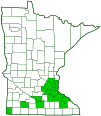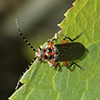two-lined leatherwing
(Atalantycha bilineata)
Conservation • Description • Habitat • Ecology • Distribution • Taxonomy
Conservation Status |
|
|||||||
| IUCN Red List | not listed |
|||||||
| NatureServe | not listed |
|||||||
| Minnesota | not listed |
|||||||
Description |
||
Two-lined leatherwing is a common, small, soldier beetle that resembles a firefly. It occurs in the United States from the east coast west to the Great Plains and in adjacent Canadian provinces. It is less common in Minnesota, where it is at the northern and western extent of its range. It is the first soldier beetle to emerge in the spring. It is found on the foliage and flowers of low plants during the day. Adults are soft-bodied, elongate, somewhat flattened, and ¼″ to ⅜″ long. The black and red colors of the adult warn potential predators of their bad taste. The head is black and is not completely concealed. The antennae are long, slender, and thread-like, and have 11 segments. The first segment is reddish-orange, the remainder is black. The third segment is longer than the second. The exoskeletal plate covering the thorax (pronotum) is wider than long, widest at the base, and narrowed in front. It is broadly rounded across at the front and partially conceals the head. The margins are broadly flattened and sharp. There is a distinct impression in the middle. The surface is dull, roughly punctured, and reddish-orange. There are two broad black spots which are sometimes elongated, giving this species its common name. The wing covers (elytra) are black, parallel-sided, leathery, and flexible. They are sometimes long enough to cover all of the abdomen, sometimes they leave the tip of the abdomen exposed. The margins are narrowly flattened and pale. The plate between the wing bases (scutellum) is well developed and visible but small. It may be reddish-orange or black. The legs are long and slender. The third segment (femur) of each leg is mostly reddish-orange but dark at the very tip. The fourth segment (tibia) and the end part of each leg (tarsus), corresponding to the foot, are entirely dark. The tarsus has 5 segments. The fourth tarsal segment is lobed on the underside. There is a pair of claws at the end of each tarsus. Only the outer claw is toothed. The head, pronotum, elytra, and legs are moderately covered with short, pale hairs. |
||
Size |
||
Total length: ¼″ to ⅜″ |
||
Similar Species |
||
The two dark,sometimes elongated spots on the pronotum are unique to this species. |
||
Habitat |
||
Forested areas |
||
Ecology |
||
Season |
||
April and May |
||
Behavior |
||
Adults are active during the day and are attracted to light at night. When disturbed, they will pull in their legs and drop to the ground. |
||
Life Cycle |
||
Mating can last for days. During that time, according to an entomologist at BugGuide.net, the female drags around the male, who appears “unable or unwilling to let go”. |
||
Larva Food |
||
Possibly rotting wood |
||
Adult Food |
||
Flower pollen and nectar |
||
Distribution |
||||
|
Sources |
|||
| 5/23/2023 | ||||
Occurrence |
||||
Common in eastern United States, less common in Minnesota |
||||
Taxonomy |
|||
Order |
Coleoptera (Beetles) | ||
Suborder |
Polyphaga (Water, Rove, Scarab, Long-horned, Leaf, and Snout Beetles) | ||
Infraorder |
Elateriformia | ||
Superfamily |
Elateroidea (click, firefly and soldier beetles) | ||
Family |
Cantharidae (soldier beetles) | ||
Subfamily |
Cantharinae | ||
Tribe |
Cantharini | ||
Genus |
Atalantycha | ||
This species was formerly placed in the genus Ancistronycha. In 2005, it was transferred to the new genus Atalantycha based on the pronotum, tarsal claws, and genitalia. |
|||
Synonyms |
|||
Ancistronycha bilineata Cantharis bilineata Cantharis bilineatus |
|||
Common Names |
|||
two-lined cantharid two-lined leatherwing |
|||
One of the first beetles to be placed in the family Cantharidae has colors reminiscent of British redcoats, which lead to the common name for the family, “soldier beetle.” |
|||
Glossary
Elytra
The hardened or leathery forewings of beetles used to protect the fragile hindwings, which are used for flying. Singular: elytron.
Femur
On insects and arachnids, the third, largest, most robust segment of the leg, coming immediately before the tibia. On humans, the thigh bone.
Pronotum
The exoskeletal plate on the upper side of the first segment of the thorax of an insect.
Scutellum
The exoskeletal plate covering the rearward (posterior) part of the middle segment of the thorax in some insects. In Coleoptera, Hemiptera, and Homoptera, the dorsal, often triangular plate behind the pronotum and between the bases of the front wings. In Diptera, the exoskeletal plate between the abdomen and the thorax.
Tarsus
On insects, the last two to five subdivisions of the leg, attached to the tibia; the foot. On spiders, the last segment of the leg. Plural: tarsi.
Tibia
The fourth segment of an insect leg, after the femur and before the tarsus (foot). The fifth segment of a spider leg or palp. Plural: tibiae.
Visitor Photos |
|||||
Share your photo of this insect. |
|||||
| This button not working for you? Simply email us at info@MinnesotaSeasons.com. Attach one or more photos and, if you like, a caption. |
|||||
Babette Kis |
|||||
Atalantycha bilineata Two lined leatherwing |
|||||
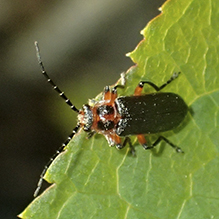 |
|||||
Alfredo Colon |
|||||
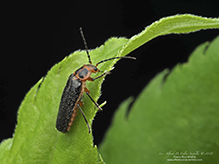 |
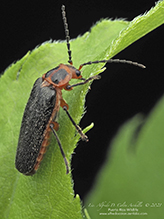 |
||||
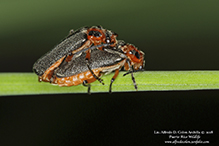 |
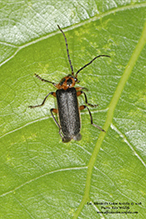 |
||||
MinnesotaSeasons.com Photos |
|||||
|
|||||

Slideshows |
||

Visitor Videos |
|||
Share your video of this insect. |
|||
| This button not working for you? Simply email us at info@MinnesotaSeasons.com. Attach a video, a YouTube link, or a cloud storage link. |
|||
Other Videos |
|||


Created: 1/17/2019
Last Updated:
